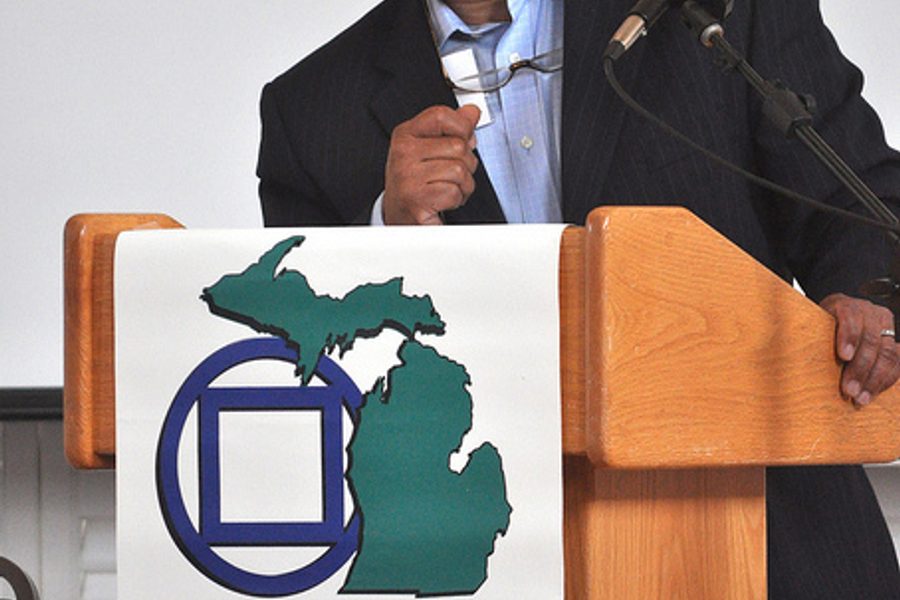
The Laboratory for Our Future is the ominous subtitle of Charles Bowden’s haunting 1998 book about Ciudad Juarez, Mexico.
The seedy but highly profitable laboratory revealed by Bowden, also author of the harrowing book Murder City about narco wars in Juarez, brings together the 19th-century model of sweatshop labor with 21st-century technology to generate maximum earnings for the U.S.-owned firms while offering minimal pay under NAFTA’s protections.
In 1999, for example, GE CEO Jack Welch collected $92 million in compensation, more than his 15,000 Mexican workers combined. U.S.-based corporations pay no taxes and only minimal annual fees in Juarez, so the vast majority of social costs are borne by the citizenry. As former Juarez Mayor Gustavo Elizondo explains, “We have no way to provide water, sewage, and sanitation works. Every year we get poorer and poorer even though we create more and more wealth.”
But at the opposite end of the globalization process from Juarez, there’s another laboratory conducting a related experiment : Benton Harbor, Mich., which once hosted jobs that have moved to places like Juarez. Like the workers in Juarez, impoverished residents of Benton Harbor — which is 92 percent African-American — have been stripped of democratic rights.
In Juarez, the prevalence of fraudulent political elections stolen and brutal repression have deprived the mostly female “maquiladora” workforce in assembly plants of any meaningful voice in either their workplaces or society.
In Benton Harbor, a unionized manufacturing workforce has been cast aside and the presence of nearly 10,000 overwhelmingly poor and black people are a potential obstacle to corporations like Whirlpool implementing a plan for redeveloping the area. Benton Harborites, too, have been rendered utterly powerless.
Thanks to Public Act 4, promoted by a Whirlpool ally and signed by GOP Gov. Rick Snyder, Benton Harbor Emergency Manager Joe Harris gained expanded powers to override decisions made by the democratically elected City Council and School Board. He literally expelled the elected mayor from his own office. Harris and other managers can also negate union contracts and other city agreements.
Gov. Snyder seems to believe that a state takeover of cities is more essential to their health than providing actual financial aid, which has been reserved for Michigan corporations in the form of $1.7 billion in tax cuts. Meanwhile, in part because of state budget cuts, Harris plans to raise water rates by about 40 percent even though 20 percent of the city’s residents can’t or won’t pay city fees.
The Whirlpool Corp., headquartered in Benton Harbor, is playing a huge role in re-shaping the city, specifically in two major projects:
- A heavily taxpayer “incentivized” new corporate campus for 4,000 professionals, as Whirlpool began off-shoring jobs in the 1980s (its Fort Smith Ark. plant is being relocated to Mexico)
- A 530-acre Harbor Shores development including a Jack Nicolaus-designed golf course, high-end shopping, and condominiums. Whirlpool is also busy promoting an “Arts District” that attracts many affluent whites but few local black residents.
Whirlpool’s role is not universally praised, as the New York Times Magazine’ Jonathan Mahler reports in his December 18 cover story:
To skeptics of the redevelopment of Benton Harbor, Whirlpool looks less like a good corporate citizen than another company manipulating the system, leveraging its power to maximize its tax breaks and taking advantage of the town’s access to federal and state grant money. (It’s worth noting that Whirlpool hasn’t paid any federal corporate income taxes in the United States for the last three years, partly, the company says, because of losses due to the recession.)
But the recession explanation covers only a small part of Whirlpool’s tax picture, according to Matt Gardner, executive director of the Washington, DC-based Institute for Taxation and Economic Policy. Losses in recent years of economic troubles in the U.S. have been offset by foreign profits.
Further, in 2007, Whirlpool reported U.S. profits of $103 million, but earned an additional $701 million abroad that will not be taxed until Whirlpool brings the money back into the United States. Moreover, Whirlpool got a federal tax rebate of $28 million that year. In 2006, $231 million in U.S. earnings were topped off by another $388 million in foreign profits.
Whirlpool’s central role in the town and redevelopment plans has led many Benton Harbor residents to feel that the corporation views them as distinctly disposable and mainly a barrier to their plans. As Mahler summarizes,
It’s being converted into a resort town for wealthy weekenders and Whirlpool employees that, when all is said and done, its struggling black population will either be driven out by the development or reduced to low-wage jobs cleaning hotel rooms, carrying golf bags or cutting grass.
Mahler observes,
The juxtaposition of Benton Harbor’s impoverished population and its two rising monuments to wealth – all wedged into a little more than four square miles – make it almost a caricature of economic disparity in America.
But at the same time, it offers a window into one possible future for towns across the country, places that can no longer support their own economies or take care of their citizens and may ultimately have no choice but to turn their fate over to private industry and nonprofits. The way things are going, more and more states may start to look like Michigan, and more and more towns may start to look like Benton Harbor.
The Benton Harbor scenario is actually a familiar one for other de-industrialized cities wracked by massive industrial job loss or poor cities wrecked by natural disasters. As Hurricane Katrina tore off roofs and exposed the destroyed interiors of homes, it also peeled back the genteel veneer of elite opinion about New Orleans revealing that many top corporate and political figures viewed the majority of its residents to be essentially irrelevant, if not an outright impediment, to the restructuring of the city’s devastated economy.
The flight of the city’s poorest citizens was viewed openly as a chance for a fresh start. It not only removed a substantial part of the Big Easy’s poor, black population for whom the city’s economic leaders no longer saw as their responsibility to provide employment, but it also severely diminished their voting power and ability to have a role in determining how the city would be rebuilt.
The Arts District formula being applied to Benton Harbor has also been tried out in my hometown of Racine, Wis., a factory town of 80,000 hollowed out by the loss of well over 40 percent of its manufacturing base since 1980.
The solution: replacing more than 13,000 mostly unionized factory jobs with a new art museum and a cluster of art galleries and crafts shops. New York Times reporter Robert Sharoff fully bought into this re-invented Racine, a vision seemingly derived from the work of neo-liberal urbanist Richard Florida:
This formerly gritty industrial city roughly 70 miles north of Chicago and 30 miles south of Milwaukee on the shores of Lake Michigan has been trying for much of the last decade to reinvent itself as an artistÕs colony and tourist destination. The efforts have included the opening of the $11 million Racine Art Museum on Main Street in 2003 and the creation of a gallery district centering on nearby Sixth Street.
This stunning premise that the museum and 12 art galleries could significantly fill in the economic Grand Canyon left by the destruction of 13,000 family-supporting factory jobs reflects the same mentality that can view the Harbor Shores development as a path to prosperity for Benton Harbor’s impoverished African-American population.
Despite Mahler’s moving and insightful description of a de-industrialized city being re-shaped by those who destroyed the economic base, with the victims being deprived of any voice, he fails to point out several fundamental features:
- Those harmed most by past corporate decisions are treated as disposable people standing in the way of corporate-defined reconstruction.
- Democracy and public participation are early victims to this process.
- With corporate elites having shrunken government’s public-interest role in planning and economic development, major “job-creation projects” must be shaped around generating profit with the needs of the majority a negligible concern.
But despite all the rhetoric about corporations rushing to the rescue of troubled cities – whether New Orleans, Benton Harbor, or Racine — massive public subsidies to CEOs advocating “free enterprise” are an essential element.
It’s a formula for private benefit with public funding, for a distorted form of “development” devoid of democracy or public benefit.








